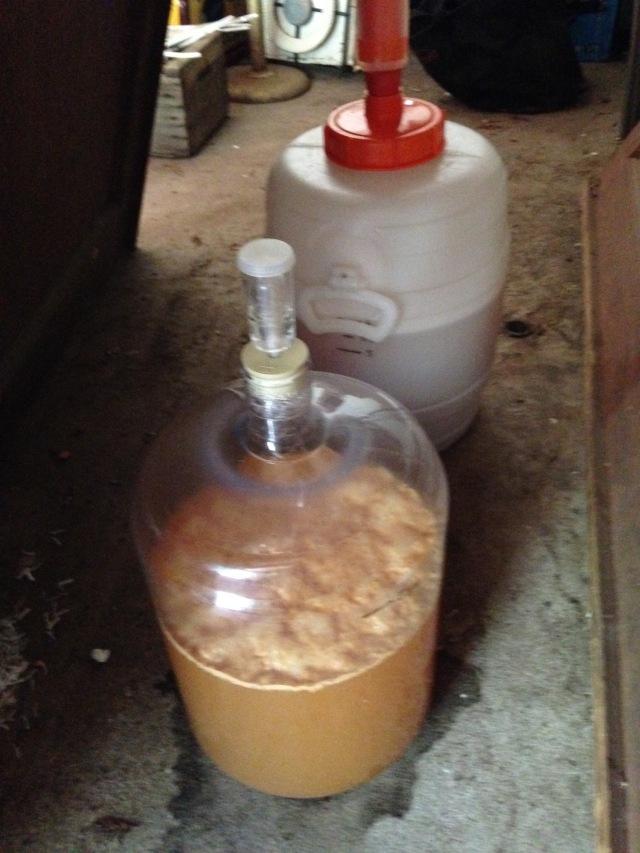After many days of research, asking questions, and washing apples, Chris and I finally got to make the cider on Labor Day, 2019. I rented an apple press and grinder from Mountain Feed and Farm. It was in good shape and worked well. One of the staff told me to cut up the apples into small pieces to not jam the grinder. We did our first load with cut apples (Pippins), and it yielded 4 cups. On the next load, Chris said to try it with whole apples. It worked so much better and definitely saved time by not having to cut up the apples. The larger apples were pulverized whereas the small pieces just fell through the grinder. We then yielded double, 8 cups of juice by using whole apples.


After grinding, we just slid the bucket forward, put on the lid, and pressed. This all-in-one unit was really nice, but an automatic press would be ideal. After each pressing, we rinsed the bag in STARSAN sanitizer, and periodically cleaned the grinder with sanitizer when apple bits needed clearing.
It takes two people to grind, and it also takes two people to spin tight the press and hold it down with your foot to get a tight squeeze.



Pippins & Gravensteins – Batch 1
- Time: 10am – 1pm
- Pressed: ~575 apples
- Yield: 5.5 gallons (57 cups Pippin; 31 cups Gravenstein)
- Yeast: Cider/Mead
- Gravity Reading: 1.040
We measured each load to calculate how many cups to gallons we were pressing (16 cups = 1 gallon). On the first batch, we had to press 10 times, and we got 5.5 gallons. The Carboy can hold 6 gallons so we were happy with 5.5 gallons.
We used all the Pippins (400) and about half the Gravensteins (175). 575 apples yielded 5.5 gallons, much less than I thought. The other difference was that the Pippins yielded 8 cups of juice per press whereas the super ripe Gravensteins yielded 10-16 cups per press. Next year we will definitely pick the Gravensteins earlier as we lost too many that fell on the ground.
Every time we transferred the juice into the boiling pot, we screened it through a sieve. There was not much pulp or bits in the juice. Everything was sanitized after each pressing. We had a big tub of water with STARSAN sanitizer that we dipped the tools in, the apple pressing bag, our hands, etc. as well as using a spray bottle.


The gravity reading with a hydrometer was 1.040 for the fresh apple juice. We added the pectin enzyme as it heated. Then, we pasteurized it. The FDA says 160 degrees for 6 seconds, Chris googled it as 161 degrees for 15 seconds. Regardless, we reached that temperature and time without a problem.

Before we even started this process, at 9:30am, we smacked the liquid Cider/Mead yeast packet to break it so it could sit for 3 hours. After pasteurizing, we let the juice cool down a bit, at least for 30 minutes. Then, we transferred it to the Carboy, oxygenated for 2 minutes, and added the yeast. We put vodka in the fermentation lock.

Golden Delicious/Gravenstein – Batch 2
- Time: 1pm – 5:30pm
- Pressed: ~380 apples
- Yield: 3.75 gallons (20 cups Gravenstein; 40 cups Golden Delicious)
- Yeast: Wine EC-1118 (Champagne)
- Gravity Reading: 1.050
The process was the same with the second batch, however, it took longer to rehydrate the dry yeast as we only had one thermometer which was used for pasteurizing. While the juice cooled down, we heated 8 ounces of distilled water to 110 degrees. However, we over heated it to 130 degrees and waited for it to cool down to 104 degrees before adding 6.5 grams of energizer. The problem was that the thermometer never went down so it obviously broke. We guestimated the temperature and mixed in the energizer and yeast, letting it sit for 30 minutes.



After shaking and oxygenating the juice for 2 minutes, we poured in the yeast and also put vodka in the fermentation lock.
I checked the Carboys on Tuesday, Sept. 3, and the champagne yeast has started to ferment.


